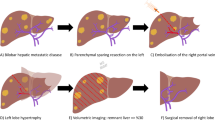Abstract
Background and aims. The mode and degree of tumor spread in gallbladder carcinoma is poorly documented. The present study classifies the patterns of dissemination of this tumor with a focus on surgical strategy.
Patients and methods. Surgical specimens from 112 patients who underwent curative resection were reviewed. There were stage I, II, III, and IV in 9, 11, 14, and 78 patients, respectively.
Results. Six types of spread were identified. In the hepatic bed type (n=20) a large mass in the fundus and body penetrated into the liver through the gallbladder bed with or without contiguous spread to the gastrointestinal tract. The extent of hepatectomy was individualized from wedge resection to extended right hepatectomy based on the clinical findings. In the hepatic hilum type (n=26) a relatively small tumor in the neck infiltrated the hepatic hilum causing obstructive jaundice. Extended right hepatectomy plus bile duct resection with or without portal vein resection was necessary for curative resection because the tumor had extended into the right portal pedicle, and postoperative hepatic failure was common. In the bed and hilum type (n=18) a huge mass occupying the entire gallbladder involved both the gallbladder bed and the hepatic hilum. Extended right hepatectomy with combined resection of contiguous spread was necessary for curative resection. In the lymph node type (n=15) enlarged metastatic lymph nodes were the most prominent feature, and the primary tumor remains limited to the gallbladder in most cases. Extended lymphadenectomy with combined individualized resection was performed. In the cystic duct type (n=9) a small mass arising from the cystic duct involved the common bile duct. This type presented at an earlier stage than the first four types. In the localized type (n=24) tumor spread is localized to the gallbladder and presented at the earliest stage of any type. Simple cholecystectomy with or without wedge hepatic resection and regional lymphadenectomy resulted in a satisfactory outcome. Prognosis depends on the stage rather than on the mode of tumor spread. Even in the advanced types favorable results may be obtained in selected patients undergoing radical resection for M0 tumors without portal vein invasion. Success also was achieved in the rare patients with para-aortic lymph node metastases that were not infiltrative.
Conclusions. These six types of gallbladder cancer can be diagnosed preoperatively by clinical and radiological examination. This information should assist the surgeon in the choice of operation and predict outcome.
Similar content being viewed by others
Author information
Authors and Affiliations
Additional information
Electronic Publication
Rights and permissions
About this article
Cite this article
Kondo, S., Nimura, Y., Kamiya, J. et al. Mode of tumor spread and surgical strategy in gallbladder carcinoma. Langenbecks Arch Surg 387, 222–228 (2002). https://doi.org/10.1007/s00423-002-0318-6
Received:
Accepted:
Issue Date:
DOI: https://doi.org/10.1007/s00423-002-0318-6




